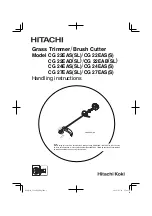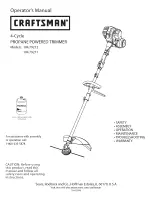
English
10
Pivoting the Trimmer Head (Fig. A, E)
The trimmer head pivots 180° and can be locked into
5 different positions within that range. To avoid being
pinched, wear gloves.
1. Press in on the locking latch
7
and raise the
trimmer head.
2. Lock the trimmer head into any of the 5 positions. Check
to make sure that trimmer head is locked into position
by trying to move the motor housing. If it is not locked,
rotate it to the closest lock position.
Switch (Fig. A)
To turn the tool ON pull the lock button
1
back with your
thumb and then squeeze the trigger
2
. (Once the tool is
running you can release the lock button.) To turn the tool
OFF, release the trigger.
Fig. E
Proper Hand Position (Fig. A, D)
WARNING:
To reduce the risk of serious personal
injury,
ALWAYS
use proper hand position as shown.
WARNING:
To reduce the risk of serious personal
injury,
ALWAYS
hold securely in anticipation of a
sudden reaction.
Always hold the trimmer, as shown in the illustrations in this
manual, with one hand on the switch handle
14
and one
hand on the foam gripper
4
.
Trimming Instructions
Working Position (Fig. D)
Maintain proper footing and balance and do not overreach.
Wear safety goggles, non-skid footwear and gloves when
trimming. Hold the tool firmly in both hands and turn
the tool ON. Always hold the trimmer, as shown in the
illustrations in this manual, with one hand on the switch
handle
14
and one hand on the foam gripper
4
. Never
hold the tool by the hand guard.
Fig. C
3
13
Trimming New Growth
A wide, sweeping motion, feeding the blade teeth through
the twigs is most effective. A slight downward tilt of the
blade, in the direction of motion gives the best cutting.
Do not cut stems greater than 3/4” (19 mm). Use the
trimmer only for cutting normal shrubbery around houses
and buildings.
Level Hedges
To obtain exceptionally level hedges a piece of string can be
stretched along the length of the hedge as a guide.
Fig. F
Fig. D
14
4













































